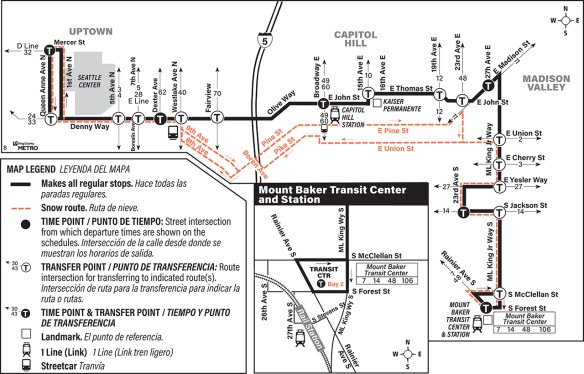
Work on the route through downtown is pretty much complete (Image: Seattle Department of Transportation)
By CHS’s calculations, construction along the Madison corridor to create the new RapidRide G bus line has another year to go. But a merchant group representing businesses along the route says patience with the construction mess, utility shutdowns, and transit impacts has run out.
“The RapidRide G – Madison St project now sits at 75% completion!,” the Seattle Department of Transportation announced in its latest construction update this week on the 2.4-mile route promising six-minute service during most hours of the day between 1st Ave downtown and MLK Jr Way in Madison Valley with stops across First Hill and Capitol Hill along the way.
But the Madison Valley Merchants Association isn’t celebrating. The group is calling on the city and Mayor Bruce Harrell to implement a small business council to address “the city’s lack of communication and planning regarding the Madison BRT project,” Marceil Van Camp, board member and owner of Kamp Social House, tells CHS.
The association cites “a substantial loss of 20% of the businesses along the Madison Avenue corridor, spanning from 24th Avenue East to 32nd Avenue East” and says “an additional loss of 10% is anticipated by the conclusion of 2023” in a letter documenting its complaints. “This persistent decline is unsustainable for the well-being of the Madison Valley community, especially when weighed against the benefits derived from the Madison Bus Rapid Transit (BRT) – RapidRide G Line project,” it reads.
Van Camp says other areas along Madison have also met with the Greater Seattle Business Association about the challenges.
The full letter can be found at the end of this report.
While the letter also cites some familiar, sometimes shortsighted concerns around things like the loss of street parking, there are plenty of more substantial issues raised in the letter including the haphazard re-routes and wholesale loss of transit service by existing key routes in the area. In its latest construction update, SDOT says the detour of Route 8 away from Madison Valley will last for months into 2024.
Unfortunately, the pains for those living along the route of the Madison project are not new. Continue reading

















